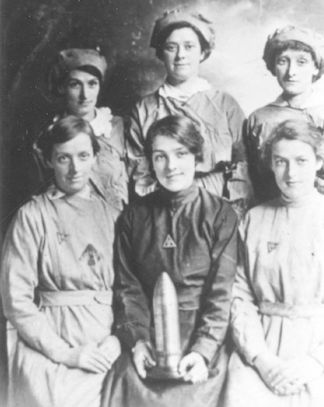The canary girls of the First World War
As part of my research for the Iris Woodmore Mystery, The Body at Carnival Bridge, I read about the extraordinary work women undertook during the First World War, particularly in the munitions factories.
In 1915, the Ministry of Munitions was founded to oversee the production and supply of munitions for the war effort. There had been newspaper criticism of the shortage of artillery shells, and David Lloyd George enhanced his political reputation thanks to his work as Minister of Munitions between 1915 and 1916.
He introduced new initiatives to improve production levels, and one of these was to encourage women to register for war work. Thousands of women volunteered, and many were employed in munitions factories across the country. The above photograph shows young munitions workers holding a shell.
By the end of the war, it’s estimated that up to one million women had worked as munitionettes.

WWI poster encouraging women to volunteer for war work
Known as munitionettes, these women worked with hazardous chemicals without adequate protection. Prolonged exposure to one of these chemicals, trinitrotoluene (TNT), turned the women’s skin and hair a lurid yellow colour. It’s reported some even gave birth to yellow babies.
As a result, the munitionettes gained a new nickname, the canary girls. In The Body at Carnival Bridge, one of the characters, Nora Fox, still has a slight yellow tinge to her skin as a result of the time she spent working in a munitions factory.
Although the yellow colour faded after time, there were more insidious long-term effects. Prolonged exposure to the chemical harmed the immune system, and it’s now known to cause liver failure, anaemia, spleen enlargement, infertility and other problems.
Of course, working with explosive materials was a constant danger. There were several tragic disasters at munitions factories during the First World War. One of the worst occurred in January 1917 in Silvertown in Essex (now part of Greater London).

Silvertown memorial
On Friday 19 January 1917, at 6.52pm, approximately 50 tonnes of TNT exploded, killing 73 people and injuring 400 more and causing substantial damage to the local area.
Another tragedy happened at the Barnbow Munitions factory at Crossgates in Leeds. On Tuesday 5th December 1916, several hundred women and girls had begun the nightshift when at around 10.30pm, an explosion killed 35 women and maimed and injured dozens more. In some cases, identification was only possible by the identity disks worn around the worker's neck.

Barnbow site after explosion
(Since posting this, I've been informed that the above photograph is often incorrectly identified as the site after the December 1916 explosion. However, apparently, that tragedy took place in Room 42, and after the injured and dead were removed, a horrific clean-up operation took place, and work resumed in that room within a few hours. This photo could have been taken following one of the later explosions.)
There were two further explosions at the Barnbow factory, one in March 1917, killing two girl workers, and one in May 1918, killing three men.
Censorship at the time meant that accounts of these explosions weren’t made public. The press didn't report tragic events such as these for fear of the impact the news would have on national morale and the war effort.
As a result, it's difficult to know the exact number of casualties.

Memorial to the Barnbow Lasses listing all those killed
The Iris Woodmore Mysteries are available in hardback, paperback, ebook and audiobook from Amazon and bookstores.

